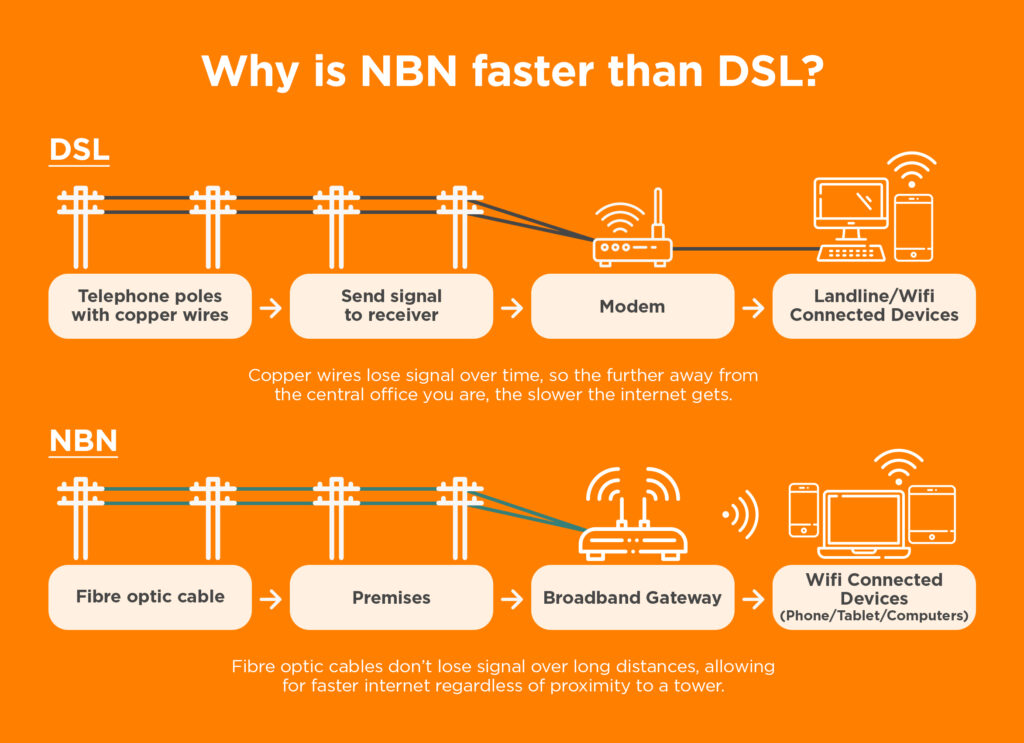What is DSL Internet?
What is DSL Internet?
*iSelect’s partnered with CIMET to help you compare a range of internet plans and providers. Not all plans or providers in the market are compared and not all plans or special offers are available at all times, through all channels or in all areas. Not all plans available from CIMET’s providers are compared and due to commercial arrangements, area or availability, not all plans compared will be available to all customers. Learn more
Compare NBN plans the easy way
Save time and effort by comparing a range of NBN plans and providers online*
How does DSL work?
Do Australians still use DSL connections?
What are the different types of DSL connections?
What are some alternatives to DSL?
Where can I compare different Internet Plans?
The year 2000 was a heady time for Australians. We got to celebrate not being wiped out by the Y2K bug. We got to critique Nikki Webster’s performance at the Sydney Olympics. And … we got DSL Internet.
More than 20 years on, DSL isn’t quite the innovation it used to be. While it was a big step up from its predecessor (remember dial-up?), it’s now almost defunct, with a little over 100,000 Australians still using it.
How does DSL work?
DSL stands for Digital Subscriber Line, and it’s the umbrella term for all those other types of Internet connection with similar names, like ADSL and ADSL2+. It’s a type of Internet connection that’s transmitted through copper wiring. The copper wires were installed for the landline phone network, and they’re not ideal for Internet connections. Because copper wires lose signal over distance, on the DSL network, the closer your house is to your provider’s telephone exchange, the higher your Internet speed, and the further away you are, the lower your speed.
Back in 2000, when DSL was rolled out, most houses already had copper wiring set up. DSL jumped on the existing technology, which meant many homes across the country could get connected fast.
The rollout was a big deal for two reasons: first, DSL was a whopping hundred times faster than dial-up. And second – and maybe even more impressively – unlike dial-up, DSL meant you could use the Internet and the home phone at the same time.

Do Australians still use DSL connections?
DSL connections are still available in Australia, though they’re being progressively decommissioned and replaced by the NBN. There are certain areas, though, where DSL is not being decommissioned – specifically, areas that fall outside NBN Co’s fixed wireless and satellite footprints. (You can check your address here.)
ADSL was already on the way out back in 2021, with fewer than 300,000 connections. As of June 2023, the switch to NBN is going strong, with over 8.7 million services active in Australia.
Helpful Tip:
Internet providers really have no incentive to offer compelling DSL deals any more with such a small number of Australians using the technology. That makes finding a bargain hard, as well as limiting the number of providers you can possibly use, with the very real prospect of even fewer choices in the future.
As such, it’s a smart move to at least explore what’s available to you outside of DSL services. You can start simple by asking your existing DSL provider what plans they have available at your address, or if they have any systems in place to make the transition away from DSL a little smoother – and maybe even a little less expensive!
What are the different types of DSL connections?
The most prominent types of DSL connection in Australia are:
- ADSL2+: The A in ADSL stands for ‘asymmetric’, meaning that the download speed is faster than the upload speed. ADSL2+ is the next step up from standard ADSL and still uses the same copper wiring but provides faster internet speeds. ADSL2+ works better than ADSL for things like video streaming, music downloading, and online gaming.
- Naked DSL: Naked DSL Plans still connect to houses using existing copper wire, but they don’t require an existing landline phone plan, which means they can be a cheaper option for those who don’t need a landline.
- VDSL2: VDSL2 is the most advanced type of DSL connection available. It still uses the copper wires in phone lines but provides high-speed internet access. Although, like other DSL connections, it’s on the way out, it’s been partially incorporated into some types of NBN connections.
What are some alternatives to DSL?
If you’re searching for a new Internet Plan, there are more modern options available, including NBN and Mobile Broadband.
Fixed NBN
The NBN is Australia’s national broadband network, which is mostly transmitted through fibre-optic cables, rather than copper wires. Fibre-optic cables are designed to transfer large amounts of data and don’t lose their signal over long distances. This makes them better suited to the way most people use the Internet today, offering higher speeds and higher capacity.
Remember, ‘Fixed NBN’ just refers to how the Internet is delivered to your house, not how you use it once it’s there. In other words, you can have Fixed NBN and still use your own Wi-Fi network at home.
Wireless NBN
In remote regions where houses are far apart from each other, making it very expensive to install fibre-optic cables, NBN access is provided in two different ways:
- Fixed Wireless, where data is sent the final stretch of the way from a tower to an antenna fitted outside the home.
- Sky Muster satellite service, where the Internet is transmitted and from a satellite dish on the house.
Quick Tip!
If you’re switching from DSL to NBN Internet but don’t want to lose your home phone, don’t stress. You can actually make phone calls over your Internet connection. Many NBN providers offer combined NBN and Phone Plans – and you can often keep your old phone number too!
Mobile Broadband
Mobile Broadband uses 3G, 4G and 5G cellular networks to connect your device to the Internet via a dongle or portable Wi-Fi router. In theory, it should allow you to access the Internet anywhere your phone network reaches.
Where can I compare different Internet Plans?
Ready to find an NBN Plan that suits you? Save time and effort by comparing a range of Internet Plans here.*

Get started on comparing NBN plans today!
Save time and effort by comparing a range of NBN plans and providers online*
*iSelect’s partnered with CIMET Sales Pty Ltd (ABN 72 620 395 726) to help you compare a range of internet plans and providers. Not all internet plan providers or plans in the market are compared. The availability of plans may change from time to time. Not all plans available from CIMET providers are compared. Due to commercial arrangements, area or availability, not all plans compared will be available to all customers. Some plans and special offers are available only from iSelect’s call centre or website. Click here to view CIMET’s range of providers. iSelect and CIMET earn a commission for every internet plan sold.

.svg)







